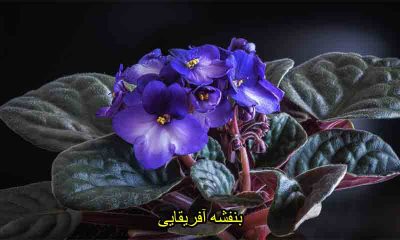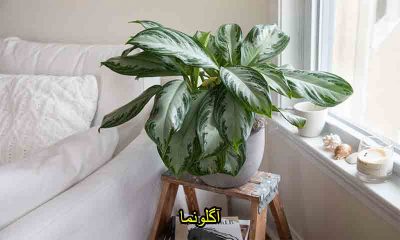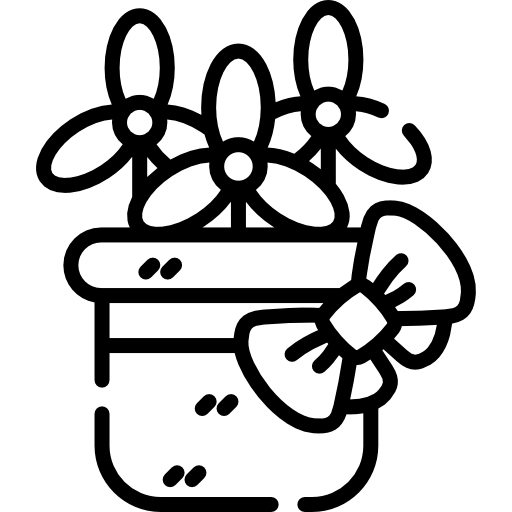همه اطلاعات ضروری درباره نگهداری از گیاهان
گیاه مورد نظرتان را پیدا نکردید؟ با ما تماس بگیرید، ما به شما کمک میکنیم!
A

بنفشه آفریقایی، یکی از محبوبترین گیاهان آپارتمانی، با گلهای ظریف و برگهای مخملیاش دل هر دوستدار گل و گیاه را میبرد. اما برای آنکه این زیبایی ماندگار بماند، باید با اصول مراقبت از آن آشنا باشید.
این گیاه عاشق نور است، اما نه از نوع مستقیم! بهترین جا برای نگهداریاش کنار پنجرهای روشن و دور از تابش مستقیم خورشید است. اگر نور طبیعی کافی ندارید، لامپهای رشد گیاه میتوانند بهترین دوست بنفشهتان باشند.
خاک مناسب برای بنفشه آفریقایی باید سبک، پر از اکسیژن و با زهکشی عالی باشد. خاکهایی که آب را در خود نگه میدارند، دشمن ریشههای ظریف این گل هستند. از آبیاری سطحی پرهیز کنید؛ اجازه دهید خاک نیمهمرطوب بماند و ترجیحاً از زیر گلدانی آبیاری کنید تا برگها آسیب نبینند.
دمای ایدهآل برای این گیاه، حدود ۲۰ تا ۲۲ درجه سانتیگراد است. سرما و خشکی هوا میتواند باعث توقف گلدهی یا پژمردگی برگها شود. رطوبت نسبی ۴۰ تا ۶۰ درصد محیطی مناسب و شاداب برای رشد بنفشه آفریقایی فراهم میکند.
برای گلدهی بهتر، از کود مخصوص بنفشه آفریقایی استفاده کرده و در فصل رشد، یعنی بهار و تابستان، آن را هر دو هفته یکبار تغذیه کنید. برگهای پژمرده را با دقت جدا کنید تا گیاه انرژی بیشتری برای رشد برگها و گلهای تازه بگذارد.
اگر بهدرستی از این گیاه مراقبت کنید، نهتنها همیشه شاداب و پرطراوت باقی میماند، بلکه خانهتان را با شکوفههایی زیبا و رنگارنگ روشن خواهد کرد. بنفشه آفریقایی، با عشق و توجه شما، میتواند به نگینی از طبیعت در فضای خانه تبدیل شود.

گیاه آگلونما، که به نام "ملکهی برگهای رنگارنگ" نیز شناخته میشود، یکی از مقاومترین و سازگارترین گیاهان آپارتمانی است. نگهداری از این گیاه نهتنها آسان است، بلکه با رعایت چند نکته ساده، میتوانید برای مدت طولانی از زیبایی و طراوت آن لذت ببرید.
☀️ نور مورد نیاز
آگلونما در نور غیرمستقیم بهترین عملکرد را دارد. نور مستقیم خورشید میتواند باعث سوختگی برگها شود، بهویژه در گونههایی که برگهای روشنتری دارند. اگر برگها رنگپریده شدهاند یا رشد گیاه کند شده، احتمالاً به نور بیشتری نیاز دارد—البته غیر مستقیم!
💧 آبیاری با دقت
مهمترین قانون در آبیاری آگلونما: نه زیاد، نه کم. اجازه دهید سطح خاک بین دو آبیاری کمی خشک شود، اما نه بهطور کامل. آبیاری بیش از حد باعث پوسیدگی ریشه و زرد شدن برگها میشود. در زمستان نیاز آبی گیاه کاهش مییابد، پس دفعات آبیاری را کمتر کنید.
🌱 خاک مناسب
آگلونما خاکی سبک و با زهکشی بالا را دوست دارد. ترکیبی از خاک گلدانی، پرلیت و کمی خاک برگ میتواند گزینهی خوبی باشد. از استفاده از خاک سنگین و فشرده خودداری کنید چون مانع از تنفس ریشهها میشود.
🌡️ دما و رطوبت
دمای ایدهآل برای آگلونما بین ۱۸ تا ۲۷ درجه سانتیگراد است. این گیاه سرمای ناگهانی و دمای کمتر از ۱۵ درجه را تحمل نمیکند. آگلونما عاشق رطوبت است، بنابراین اگر در منطقهای خشک زندگی میکنید، با استفاده از دستگاه بخور یا قرار دادن سینی آب در نزدیکی گیاه، رطوبت لازم را تأمین کنید.
🌿 کوددهی
در فصل رشد (بهار و تابستان) ماهی یکبار از کود مایع مخصوص گیاهان آپارتمانی استفاده کنید. در پاییز و زمستان نیاز به کود بسیار کم میشود، پس بهتر است کوددهی را متوقف کنید.
✂️ هرس و تمیز کردن برگها
برای حفظ ظاهر زیبا و سالم گیاه، برگهای زرد، خشک یا بیمار را از انتهای ساقه جدا کنید. همچنین با یک دستمال نمدار سطح برگها را بهصورت دورهای پاک کنید تا تنفس برگها مختل نشود و گیاه بتواند نور را بهتر جذب کند.
⚠️ سمی بودن گیاه
یادتان باشد که آگلونما برای حیوانات خانگی (مانند سگ و گربه) و کودکان سمی است. مواد موجود در برگهای این گیاه میتواند باعث تحریک دهان و دستگاه گوارش شود، پس آن را دور از دسترس قرار دهید.
 This plant is native to the tropical forests of Southeast Asia and Oceania. For decades, plants in the Croton family were considered outdoor-only, needing several hours of direct light to thrive.
This plant is native to the tropical forests of Southeast Asia and Oceania. For decades, plants in the Croton family were considered outdoor-only, needing several hours of direct light to thrive.
Croton petra plants are susceptible to the bacterial diseases crown gall and xanthomonas leaf spot, and the fungal diseases anthracnose and stem gall and canke Shop this plant
 This plant is native to the tropical forests of Southeast Asia and Oceania. For decades, plants in the Croton family were considered outdoor-only, needing several hours of direct light to thrive.
This plant is native to the tropical forests of Southeast Asia and Oceania. For decades, plants in the Croton family were considered outdoor-only, needing several hours of direct light to thrive.
Croton petra plants are susceptible to the bacterial diseases crown gall and xanthomonas leaf spot, and the fungal diseases anthracnose and stem gall and canke Shop this plant
 This plant is native to the tropical forests of Southeast Asia and Oceania. For decades, plants in the Croton family were considered outdoor-only, needing several hours of direct light to thrive.
This plant is native to the tropical forests of Southeast Asia and Oceania. For decades, plants in the Croton family were considered outdoor-only, needing several hours of direct light to thrive.
Croton petra plants are susceptible to the bacterial diseases crown gall and xanthomonas leaf spot, and the fungal diseases anthracnose and stem gall and canke Shop this plant
 This plant is native to the tropical forests of Southeast Asia and Oceania. For decades, plants in the Croton family were considered outdoor-only, needing several hours of direct light to thrive.
This plant is native to the tropical forests of Southeast Asia and Oceania. For decades, plants in the Croton family were considered outdoor-only, needing several hours of direct light to thrive.
Croton petra plants are susceptible to the bacterial diseases crown gall and xanthomonas leaf spot, and the fungal diseases anthracnose and stem gall and canke Shop this plant
 This plant is native to the tropical forests of Southeast Asia and Oceania. For decades, plants in the Croton family were considered outdoor-only, needing several hours of direct light to thrive.
This plant is native to the tropical forests of Southeast Asia and Oceania. For decades, plants in the Croton family were considered outdoor-only, needing several hours of direct light to thrive.
Croton petra plants are susceptible to the bacterial diseases crown gall and xanthomonas leaf spot, and the fungal diseases anthracnose and stem gall and canke Shop this plant
B
 This plant is native to the tropical forests of Southeast Asia and Oceania. For decades, plants in the Croton family were considered outdoor-only, needing several hours of direct light to thrive.
This plant is native to the tropical forests of Southeast Asia and Oceania. For decades, plants in the Croton family were considered outdoor-only, needing several hours of direct light to thrive.
Croton petra plants are susceptible to the bacterial diseases crown gall and xanthomonas leaf spot, and the fungal diseases anthracnose and stem gall and canke Shop this plant
 This plant is native to the tropical forests of Southeast Asia and Oceania. For decades, plants in the Croton family were considered outdoor-only, needing several hours of direct light to thrive.
This plant is native to the tropical forests of Southeast Asia and Oceania. For decades, plants in the Croton family were considered outdoor-only, needing several hours of direct light to thrive.
Croton petra plants are susceptible to the bacterial diseases crown gall and xanthomonas leaf spot, and the fungal diseases anthracnose and stem gall and canke Shop this plant
 This plant is native to the tropical forests of Southeast Asia and Oceania. For decades, plants in the Croton family were considered outdoor-only, needing several hours of direct light to thrive.
This plant is native to the tropical forests of Southeast Asia and Oceania. For decades, plants in the Croton family were considered outdoor-only, needing several hours of direct light to thrive.
Croton petra plants are susceptible to the bacterial diseases crown gall and xanthomonas leaf spot, and the fungal diseases anthracnose and stem gall and canke Shop this plant
 This plant is native to the tropical forests of Southeast Asia and Oceania. For decades, plants in the Croton family were considered outdoor-only, needing several hours of direct light to thrive.
This plant is native to the tropical forests of Southeast Asia and Oceania. For decades, plants in the Croton family were considered outdoor-only, needing several hours of direct light to thrive.
Croton petra plants are susceptible to the bacterial diseases crown gall and xanthomonas leaf spot, and the fungal diseases anthracnose and stem gall and canke Shop this plant
C
 This plant is native to the tropical forests of Southeast Asia and Oceania. For decades, plants in the Croton family were considered outdoor-only, needing several hours of direct light to thrive.
This plant is native to the tropical forests of Southeast Asia and Oceania. For decades, plants in the Croton family were considered outdoor-only, needing several hours of direct light to thrive.
Croton petra plants are susceptible to the bacterial diseases crown gall and xanthomonas leaf spot, and the fungal diseases anthracnose and stem gall and canke Shop this plant
 This plant is native to the tropical forests of Southeast Asia and Oceania. For decades, plants in the Croton family were considered outdoor-only, needing several hours of direct light to thrive.
This plant is native to the tropical forests of Southeast Asia and Oceania. For decades, plants in the Croton family were considered outdoor-only, needing several hours of direct light to thrive.
Croton petra plants are susceptible to the bacterial diseases crown gall and xanthomonas leaf spot, and the fungal diseases anthracnose and stem gall and canke Shop this plant
 This plant is native to the tropical forests of Southeast Asia and Oceania. For decades, plants in the Croton family were considered outdoor-only, needing several hours of direct light to thrive.
This plant is native to the tropical forests of Southeast Asia and Oceania. For decades, plants in the Croton family were considered outdoor-only, needing several hours of direct light to thrive.
Croton petra plants are susceptible to the bacterial diseases crown gall and xanthomonas leaf spot, and the fungal diseases anthracnose and stem gall and canke Shop this plant
 This plant is native to the tropical forests of Southeast Asia and Oceania. For decades, plants in the Croton family were considered outdoor-only, needing several hours of direct light to thrive.
This plant is native to the tropical forests of Southeast Asia and Oceania. For decades, plants in the Croton family were considered outdoor-only, needing several hours of direct light to thrive.
Croton petra plants are susceptible to the bacterial diseases crown gall and xanthomonas leaf spot, and the fungal diseases anthracnose and stem gall and canke Shop this plant
 This plant is native to the tropical forests of Southeast Asia and Oceania. For decades, plants in the Croton family were considered outdoor-only, needing several hours of direct light to thrive.
This plant is native to the tropical forests of Southeast Asia and Oceania. For decades, plants in the Croton family were considered outdoor-only, needing several hours of direct light to thrive.
Croton petra plants are susceptible to the bacterial diseases crown gall and xanthomonas leaf spot, and the fungal diseases anthracnose and stem gall and canke Shop this plant
 This plant is native to the tropical forests of Southeast Asia and Oceania. For decades, plants in the Croton family were considered outdoor-only, needing several hours of direct light to thrive.
This plant is native to the tropical forests of Southeast Asia and Oceania. For decades, plants in the Croton family were considered outdoor-only, needing several hours of direct light to thrive.
Croton petra plants are susceptible to the bacterial diseases crown gall and xanthomonas leaf spot, and the fungal diseases anthracnose and stem gall and canke Shop this plant
D
 This plant is native to the tropical forests of Southeast Asia and Oceania. For decades, plants in the Croton family were considered outdoor-only, needing several hours of direct light to thrive.
This plant is native to the tropical forests of Southeast Asia and Oceania. For decades, plants in the Croton family were considered outdoor-only, needing several hours of direct light to thrive.
Croton petra plants are susceptible to the bacterial diseases crown gall and xanthomonas leaf spot, and the fungal diseases anthracnose and stem gall and canke Shop this plant
 This plant is native to the tropical forests of Southeast Asia and Oceania. For decades, plants in the Croton family were considered outdoor-only, needing several hours of direct light to thrive.
This plant is native to the tropical forests of Southeast Asia and Oceania. For decades, plants in the Croton family were considered outdoor-only, needing several hours of direct light to thrive.
Croton petra plants are susceptible to the bacterial diseases crown gall and xanthomonas leaf spot, and the fungal diseases anthracnose and stem gall and canke Shop this plant
 This plant is native to the tropical forests of Southeast Asia and Oceania. For decades, plants in the Croton family were considered outdoor-only, needing several hours of direct light to thrive.
This plant is native to the tropical forests of Southeast Asia and Oceania. For decades, plants in the Croton family were considered outdoor-only, needing several hours of direct light to thrive.
Croton petra plants are susceptible to the bacterial diseases crown gall and xanthomonas leaf spot, and the fungal diseases anthracnose and stem gall and canke Shop this plant
 This plant is native to the tropical forests of Southeast Asia and Oceania. For decades, plants in the Croton family were considered outdoor-only, needing several hours of direct light to thrive.
This plant is native to the tropical forests of Southeast Asia and Oceania. For decades, plants in the Croton family were considered outdoor-only, needing several hours of direct light to thrive.
Croton petra plants are susceptible to the bacterial diseases crown gall and xanthomonas leaf spot, and the fungal diseases anthracnose and stem gall and canke Shop this plant
 This plant is native to the tropical forests of Southeast Asia and Oceania. For decades, plants in the Croton family were considered outdoor-only, needing several hours of direct light to thrive.
This plant is native to the tropical forests of Southeast Asia and Oceania. For decades, plants in the Croton family were considered outdoor-only, needing several hours of direct light to thrive.
Croton petra plants are susceptible to the bacterial diseases crown gall and xanthomonas leaf spot, and the fungal diseases anthracnose and stem gall and canke Shop this plant
 This plant is native to the tropical forests of Southeast Asia and Oceania. For decades, plants in the Croton family were considered outdoor-only, needing several hours of direct light to thrive.
This plant is native to the tropical forests of Southeast Asia and Oceania. For decades, plants in the Croton family were considered outdoor-only, needing several hours of direct light to thrive.
Croton petra plants are susceptible to the bacterial diseases crown gall and xanthomonas leaf spot, and the fungal diseases anthracnose and stem gall and canke Shop this plant

